
Ecolux Solar from Zeta Specialist Lighting incorporates discreet and flexible PV solar panels which harness the sun’s energy throughout the day
Modern sign lighting systems have come a long way since 1840 when the first illuminated, gas-lit sign was used to advertise PT Barnum’s Museum, and even since 1908 when the first electrical advertisements appeared at London’s landmark Piccadilly Circus, where Perrier was the first brand to be illuminated, using incandescent light bulbs. In the 1920s, vivid, eye-catching neon signs became the flavour of the day and while neon, and in particular exposed neon, still has its followers, the sector is now largely dominated by LED-based systems.
The light fantastic
As a specialist in LED lighting technology since its introduction in the late 1990s, Germany-based Majert has an ongoing research programme to develop new and diverse solutions that use the most technically advanced components to ensure long-term and problem-free operation in all conditions. These components include diodes, lens, heat sinks, and circuitry.
The company’s Chiplite range of LED lighting systems comprise a baseline of twelve different models which provide solutions for backlighting of, for example, sign boxes with a shallow depth of 40mm, individual built-up letters from 30mm in depth and upwards, side-illumination for down/up lighters, and advanced multi-coloured animated displays.
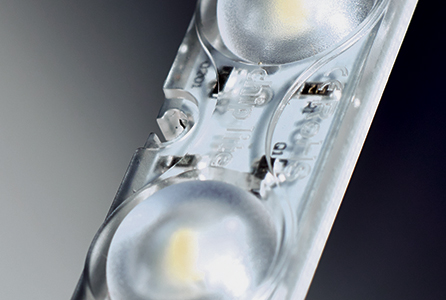
Majert Chiplite LED lighting modules provide solutions for backlighting of sign boxes with a shallow depth of 40mm
A recent significant development has been the addition of the new CL-Flexo LED module to the earlier expanded CL-X series of modules.
“This now provides a radically enhanced solution for illuminated lightbox installations,” asserts Marco Klan, sales and marketing director at Majert, Germany, adding: “A key design feature of the module is the specially developed optical lens that provides a 170-degree lighting capability to enable shadow-free illumination of sign boxes.”

A key design feature of the module is the specially developed optical lens that provides a 170-degree lighting capability to enable shadow-free illumination of sign boxes”
This has been supplemented with the latest CL Neon Flex LED module, which comes in two versions to accommodate different installation requirements. The module simulates the effects of neon lighting and incorporates all of the design attributes of the CL Flexo model. In common with all Chiplite LED modules, both of these models carry RoHS (Restriction of Hazardous Substances) certification and a CE rating in accordance with BS EN 55015. They are also IP65 rated to BS EN 60529 relating to the sealing effectiveness on electrical enclosures against the ingress of dirt, water, and other contaminants.
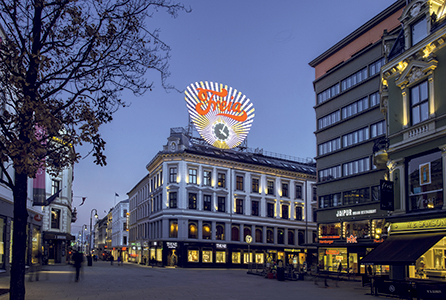
This installation at a city location uses Chiplite LED lighting modules from Majert
“Chiplite LED modules provide a wide choice of luminous flux, power consumption levels and optical efficiencies to accommodate virtually any lightbox, sign box or illuminated sign tray lettering requirement,” claims Klan, adding: “The Chiplite brand has been at the forefront of LED lighting technology from the outset and has made a significant contribution to many of the most prestigious signage projects, both in the UK and throughout Continental Europe.”
Klan offers some timely advice to sign-makers regarding LED lighting systems: “For signage to function efficiently and with only a minimal maintenance requirement, it is important always to invest in good quality LED lighting systems from recognised professional manufacturers and avoid the temptation to opt for cheaper, but intrinsically inferior, alternative systems in order to cut installation costs. The use of such systems often results in early failure and with little or no access to technical support and/or easy product replacement.”

It is important always to invest in good quality LED lighting systems from recognised professional manufacturers”
Klan cautions: “Using these cheaper LED lighting systems will lead to all kinds of operational problems in the short-term. These relate primarily to premature fading or degradation of light output efficiency (including ‘yellowing’ and ‘spotting’ of the transmitted light) and the resultant additional costs of product replacement, on-site labour and access equipment hire.”
Klan adds: “Quality LED lighting systems offer distinct advantages over traditional fluorescent and/or neon systems in terms of higher cost-effectiveness, reduced environmental impact, and enhanced performance over a longer lifetime. Compared with fluorescent or neon systems, LED-powered systems operate at a much lower voltage (typically 12V). They are therefore much safer and more cost-effective in use and capable of reducing energy consumption, by as much as 70 percent. Some also have a product lifetime of 50,000 hours, contingent upon the nature of the application and environmental factors like ambient temperature.”
A heightened performance
Applelec has recently seen LED systems become increasingly application specific, leading to greatly improved performance when modules are used according to their intended purpose.
The West Yorkshire-based manufacturer and trade supplier is a UK distributor for Sloan LED’s systems. And head of signage sales at Applelec, Andy Armitage, says that Poster Box 3 modules are a case in point.
.jpg)
Sloan LED Poster Box 3 modules, available from Applelec, are designed to illuminate large yet narrow flex face lightboxes
Armitage expands: “Designed to illuminate large yet narrow flex face lightboxes, just two rows of modules are required to illuminate a maximum width of 3m, with single-sided lightboxes as shallow as 50mm or double-sided lightboxes at just 100mm deep both possible.”
When used to illuminate flex face lightboxes, what sets the Poster Box 3 module apart according to Applelec is its ease of installation.
“Just two rows of facing modules are required along the top and bottom edge of the lightbox frame to deliver bright and even illumination across a maximum width of three metres,” explains Armitage, adding: “This is in comparison to the time-consuming method required to install many LED modules and LED ribbon systems, which need to be positioned in equally spaced rows across along a ‘back board’ to illuminate each lightbox.
“The use of Poster Box 3 greatly reduces the installation time required to populate a lightbox, whilst being much more energy efficient than LED tape or ribbon, which is still widely used in such applications,” adds Armitage.
Nebula Creative recently selected the Poster Box 3 system from Applelec to create two rock ‘n’ roll lightboxes for the first direct arena in Leeds, with one lightbox almost 5m in length and a second at almost 10m in length. “A 2 x 5m lightbox similar to that designed by Nebula Creative would require just 20 Poster Box 3 modules and draw approximately 266W,” Armitage notes.
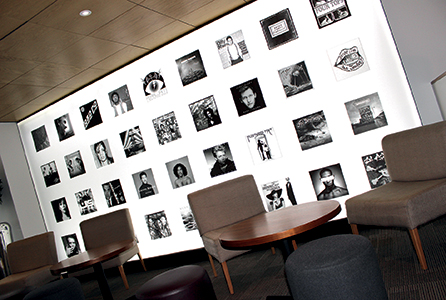
Nebula Creative recently selected the Poster Box 3 system from Applelec to create two rock ‘n’ roll lightboxes for the First Direct Arena in Leeds
As a distributor for the full range of Sloan LED systems, including the Poster Box 3 module, Applelec can provide energy consumption calculations for the sign lighting systems they quote for.
“These calculations can assist our customers in securing work as they are able to illustrate future energy savings to their clients who may be choosing between LED systems. A five year warranty is another marker of the performance and reliability of the Poster Box 3 system,” Armitage concludes.
Slim pickings
In many environments today end-users are looking for eye-catching solutions that provide maximum impact of the visual image, while the physical means of presentation goes virtually unnoticed.
Leicestershire-based visual display specialist, Innotech, recently launched the Super Slim LED Lightbox, which the company describes as the thinnest available to the market.
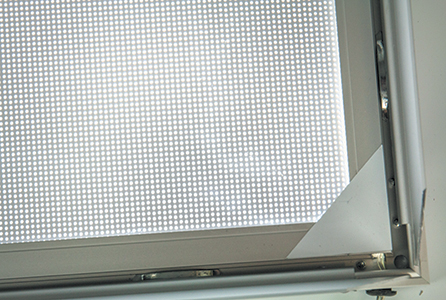
Widely dispersed LEDs create a smooth consistent backlit glow behind the poster area for Innotech’s Super Slim lightbox
With a depth of just 12mm depth and a consistent back glow from an LED panel behind the poster area, the Super Slim LED Lightbox is available in seven different sizes, from A3 to A0. It also features a snap mechanism that folds back into the profile, allowing multiple frames to be mounted side-by-side to create a larger display, and graphics to be changed easily without having to take them off the wall.
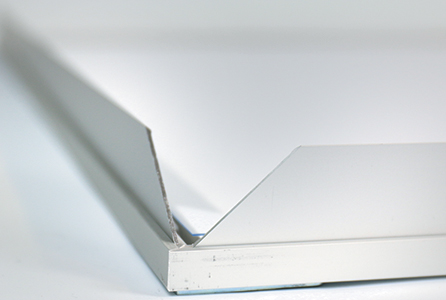
Innotech’s Super Slim lightbox features a snap mechanism that folds back into the frame, allowing lightboxes to be mounted side by side
Russell Alexander, UK sales manager at Innotech, says: “The Super Slim LED Lightbox is an industry game changer. It was launched in response to demands for reducing the depth of display systems, and what makes this product unique is its ability to have a high impact with minimum space.”
Since its launch, Innotech says it has been receiving orders of 400 units at a time, after a number of their customers started promoting the product to multi-store retailers.
“The high levels of interest for the Super Slim LED Lightbox occurs when we show it to our customers. This confirms that this product is changing the lightbox market,” adds Alexander.
Off the grid
Hot on the heels of LED lighting is solar power, which has great appeal both economically and environmentally.
One company addressing this demand is Zeta Specialist Lighting, which offers a wide range of UK-manufactured LED and solar lighting solutions for an ever-increasing number of signage applications.
The Oxfordshire company’s most recent innovative developments include Ecolux Solar, which the company claims to be the industry’s first LED trough lighting system that is entirely powered by solar. It now boasts a new ‘Super Lens’ that enables even illumination on signs up to 3m deep; the new LED Light Guide Panel (LGP), a flexible, energy-efficient solution to deliver optimum illumination across a variety of signage applications including wayfinding, advertising poster cases, totems, monoliths, and even road signs; and the Smart Scape Solar Bollard, a solar-powered wayfinding solution, and the first solar-powered system in Zeta’s Smart Scape range of street and area lighting solutions.
.jpg)
Zeta’s new LED Light Guide Panel (LGP) offers a flexible, energy-efficient solution to deliver optimum illumination across a variety of signage applications
“Zeta combines solar panels, clever control technology and long-life batteries with LEDs, to produce innovative, cost- and energy-efficient solar-powered signage solutions,” explains managing director Adrian Dennis, adding: “These off-grid systems enable sign-makers to illuminate new signage and/or retro-fit legacy signage in areas where there is no mains connection and where the cost and time associated with laying cabling to link into a mains connection is prohibitive.”
The Ecolux Solar, for example, incorporates discreet and flexible PV solar panels which harness the sun’s energy throughout the day. Zeta’s Energy Management System (EMS) releases the stored energy and uses it to power the high intensity LED trough light to provide optimum, efficient LED illumination for signs up to 3m deep.
“It has an impressive 120° beam angle, is available in a wide range of colour temperatures from 3,000 to 6,000K and importantly, projection is just 500mm compared with the earlier requirement for a 1,300mm projection bracket,” remarks Dennis.
Zeta’s Light Guide Panel has a unique grid pattern etched into the acrylic that has been specifically designed to deliver shadow free illumination and uniform light distribution, ensuring optimum performance.
“It’s a maintenance-free, low power alternative to fluorescent light sources and can be combined with the Zeta Solar Kit, which enables sign-makers to offer clients solar-powered signage illumination. This reduces both the installation and running costs,” Dennis points out.
Available in aluminium and wood finishes, the Smart Scape Solar Bollard captures and stores solar power via its integrated PV panels and requires no on-grid connection. It contains two LED lights—one runs at a low lighting level continuously, ensuring it can be seen from a distance, while the second downlight reflector lamp incorporates integrated PIR sensors that automatically increase the lighting level when there is activity in the area, saving energy and reducing light pollution.
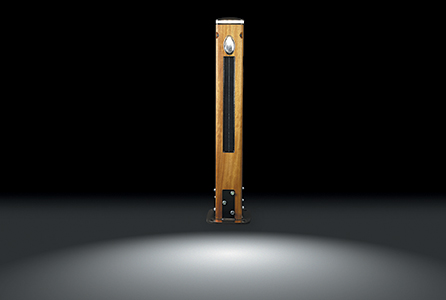
(Above & below) Available in aluminium and wood finishes, Zeta’s Smart Scape Solar Bollard captures and stores solar power via its integrated PV panels and requires no on-grid connection
Dennis adds: “This solar-powered wayfinding solution is robust, vandal resistant and extremely easy to install, with surface and root mounting options; and once installed there are zero running costs.”
Outlining the opportunities that these products offer to sign-makers, Dennis emphasises: “Signs which are illuminated are more attractive and more useful, and the ability to incorporate lighting in both new and legacy signage provides incremental revenue opportunities for sign-makers, as well as increasing their value-add to clients.
“As well as the long lifetime and performance benefits of LEDs, the additional benefit of solar-powered LED systems is that they consume zero energy and therefore have no ongoing running costs. Plus, as there is no requirement to link into a mains connection, installation is quick, easy and costs less.”
O Factoid: The first illuminated sign dates back to 1840 when PT Barnum’s Museum was advertised by a gas-lit display. O
Dennis concludes: “Zeta’s solutions are easy to work with and easy to install. For example, the Ecolux Solar includes two different pre-set positions and bracket projections, which enables sign-makers to achieve the optimum beam angle without having to wait for darkness to make any adjustment. Also, Zeta’s Light Guide Panel can be used in both single and double-sided applications and is suitable for both outdoor and indoor use.
“In addition, as Zeta’s LEDs are available in a range of colour temperatures along with RGB options, there is scope for sign-makers to offer a range of different effects and mood lighting to clients.”
It is evident that the options now available for illuminated signage are becoming ever wider and more sophisticated and yet some of the latest developments harness a force that is as old as the universe—the power of the sun. So, you could say that what goes around comes around.
Your text here...